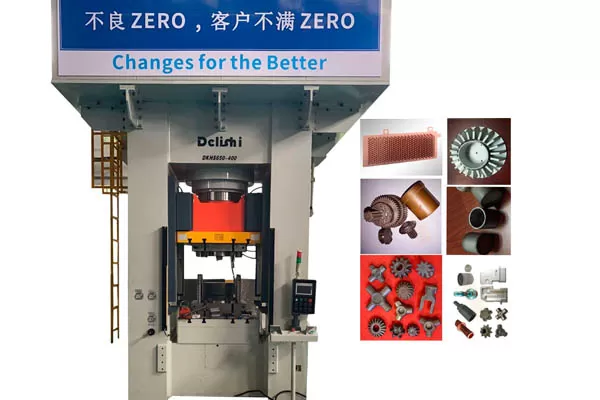
High-precision forming
Cold forging hydraulic press can achieve high-precision part forming during the processing process. Because it adopts a hydraulic drive system, the pressure can be precisely controlled, so that the metal material can be cold forged in the mold according to the preset shape. For example, when producing automotive parts such as connecting rods, the dimensional accuracy of the connecting rod can be accurately controlled, and its dimensional tolerance can be controlled within a very small range, generally reaching ±0.05mm or even higher accuracy. This helps to improve product quality and reduce subsequent processing steps.
High material utilization rate
The cold forging process itself has the characteristics of high material utilization rate, and the cold forging hydraulic press can give full play to this advantage. During the cold forging process, the material is mainly formed by plastic deformation, and very little waste such as chips is generated. Compared with traditional cutting processing, cold forging hydraulic press processing can increase material utilization rate to more than 80% - 90%. For example, when manufacturing some small precision hardware parts, such as nuts and bolts, almost all raw materials can be converted into finished products through cold forging hydraulic press processing, greatly reducing material waste.
Improve product strength
The products processed by cold forging hydraulic press have higher strength. During the cold forging process, the grain structure of the metal material will be refined and densified, so that the mechanical properties of the product are significantly improved. Taking the gear after cold forging as an example, the hardness and strength of its teeth are significantly improved compared with the traditional processing method, and the hardness can be increased by about 20% - 30%. This makes the product more wear-resistant and fatigue-resistant in actual use, able to withstand greater loads, and prolongs the service life of the product.
Good surface quality
Cold forging hydraulic press can produce products with good surface quality. Since the cold forging process is carried out at room temperature and the metal material gradually deforms under the constraint of the mold, the surface of the product is relatively smooth and the roughness is low. The surface roughness of general cold forging products can reach Ra0.8 - Ra1.6μm. For example, when manufacturing some decorations or precision instrument parts that require high appearance and surface quality, the surface of the product processed by the cold forging hydraulic press can meet the requirements without too much subsequent treatment, reducing the surface grinding, polishing and other processes.
High production efficiency
The cold forging hydraulic press has a high working speed and degree of automation, and can achieve efficient production. It can quickly complete a cold forging process, and after being equipped with suitable automation devices, such as automatic feeding system, automatic unloading system, etc., it can achieve continuous and uninterrupted production. For example, in some large cold forging production workshops, an advanced cold forging hydraulic press can complete 10-15 parts cold forging per minute, greatly improving production efficiency and meeting the needs of large-scale production.
Long mold life
Compared with the molds used in some other processing methods, the molds used in cold forging hydraulic presses have a relatively long life. Because cold forging is carried out at room temperature, the mold is subjected to less thermal stress. Moreover, during the cold forging process, the friction between the mold and the material is relatively stable, and the wear is relatively uniform. For example, under appropriate lubrication and process conditions, cold forging dies can produce tens of thousands or even hundreds of thousands of products before they need to be replaced, which reduces the frequency of die replacement and production costs.
Energy saving and environmental protection
Cold forging hydraulic presses have the advantages of energy saving and environmental protection in the production process. From an energy perspective, since its hydraulic system can accurately control energy output according to actual processing needs, compared with some traditional processing equipment, such as hot forging equipment, it has lower energy consumption. At the same time, the cold forging process does not require heating of metal materials, which avoids a large amount of energy consumption during the heating process. From an environmental protection perspective, the cold forging hydraulic press rarely produces waste and exhaust gas during the processing process, and has less pollution to the environment, which is in line with the concept of modern green manufacturing.


 +86-769-8306-1993
+86-769-8306-1993
 E-mail
E-mail
